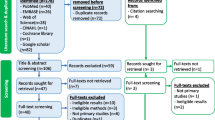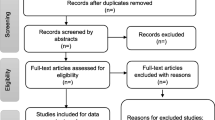Abstract
Purpose
American Indian/Alaska Native (AI/AN) populations experience significantly higher incidence and mortality rates of cervical cancer. The objective of this systematic scoping review is to characterize the volume and nature of research being conducted specific to the AI/AN population regarding cervical cancer and related clinical themes.
Methods
This scoping review was conducted in collaboration with the Pacific Northwest Evidence-based Practice Center. Search strategies identified eligible publications from 1990 through 4 February 2022. Two reviewers independently abstracted study data, including clinical area, number of participants and percent inclusion of AI/AN, intervention or risk factor, outcomes reported, Indian Health Service (IHS) Region, and funding source. We used published algorithms to assess study design.
Results
Database searches identified 300 unique citations. After full-text evaluation of 129 articles, 78 studies and 9 secondary publications were included (total of 87). Approximately 74% of studies were observational in design, with cross-sectional methodology accounting for 42.7% of all included studies. The most common clinical theme was cervical cancer screening. The most common intervention/exposure was risk factor, typically race (AI/AN compared with other groups) (69%). For studies with documented funding sources, 67% were funded by the US Government.
Conclusion
Of the small number of publications identified, the majority are funded through government agencies, are descriptive and/or cross-sectional studies that are hypothesis generating in nature, and fail to represent the diversity of the AI/AN populations in the US. This systematic scoping review highlights the paucity of rigorous research being conducted in a population suffering from a greater burden of disease.




Similar content being viewed by others
Data availability
The data that support the findings of this study are available in Ovid MEDLINE®, the Cochrane Database of Systematic Reviews, and the Cochrane Central Register of Controlled Trials which are available via the URL/DOI cited in reference section.
References
Sung H, Ferlay J, Siegel RL et al (2021) Global cancer statistics 2020: GLOBOCAN estimates of incidence and mortality worldwide for 36 cancers in 185 countries. CA Cancer J Clin 71(3):209–249. https://doi.org/10.3322/caac.21660
Arbyn M, Weiderpass E, Bruni L et al (2020) Estimates of incidence and mortality of cervical cancer in 2018: a worldwide analysis. Lancet Glob Health 8(2):e191–e203. https://doi.org/10.1016/S2214-109X(19)30482-6
Siegel RL, Miller KD, Fuchs HE, Jemal A (2021) Cancer statistics, 2021. CA Cancer J Clin 71(1):7–33. https://doi.org/10.3322/caac.21654
Cohen PA, Jhingran A, Oaknin A, Denny L (2019) Cervical cancer. Lancet 393(10167):169–182. https://doi.org/10.1016/S0140-6736(18)32470-X
de Sanjose S, Quint WG, Alemany L et al (2010) Human papillomavirus genotype attribution in invasive cervical cancer: a retrospective cross-sectional worldwide study. Lancet Oncol 11(11):1048–1056. https://doi.org/10.1016/S1470-2045(10)70230-8
Burd EM (2003) Human papillomavirus and cervical cancer. Clin Microbiol Rev 16(1):1–17. https://doi.org/10.1128/CMR.16.1.1-17.2003
Huh WK, Ault KA, Chelmow D et al (2015) Use of primary high-risk human papillomavirus testing for cervical cancer screening: interim clinical guidance. Gynecol Oncol 136(2):178–182. https://doi.org/10.1016/j.ygyno.2014.12.022
Saslow D, Solomon D, Lawson HW et al (2012) American Cancer Society, American Society for Colposcopy and Cervical Pathology, and American Society for Clinical Pathology screening guidelines for the prevention and early detection of cervical cancer. J Low Genit Tract Dis 16(3):175–204. https://doi.org/10.1097/LGT.0b013e31824ca9d5
Buskwofie A, David-West G, Clare CA (2020) A review of cervical cancer: incidence and disparities. J Natl Med Assoc 112(2):229–232. https://doi.org/10.1016/j.jnma.2020.03.002
Fuzzell LN, Perkins RB, Christy SM, Lake PW, Vadaparampil ST (2021) Cervical cancer screening in the United States: challenges and potential solutions for underscreened groups. Prev Med 144:106400. https://doi.org/10.1016/j.ypmed.2020.106400
Watson M, Benard V, Thomas C, Brayboy A, Paisano R, Becker T (2014) Cervical cancer incidence and mortality among American Indian and Alaska Native women, 1999–2009. Am J Public Health 104(Suppl 3):S415–S422. https://doi.org/10.2105/AJPH.2013.301681
Bruegl AS, Joshi S, Batman S, Weisenberger M, Munro E, Becker T (2020) Gynecologic cancer incidence and mortality among American Indian/Alaska Native women in the Pacific Northwest, 1996–2016. Gynecol Oncol 157(3):686–692. https://doi.org/10.1016/j.ygyno.2020.03.033
Becker TM, Espey DK, Lawson HW, Saraiya M, Jim MA, Waxman AG (2008) Regional differences in cervical cancer incidence among American Indians and Alaska Natives, 1999–2004. Cancer 113(5 Suppl):1234–1243. https://doi.org/10.1002/cncr.23736
Jacobs-Wingo JL, Jim CC, Groom AV (2017) Human papillomavirus vaccine uptake: increase for American Indian adolescents, 2013–2015. Am J Prev Med 53(2):162–168. https://doi.org/10.1016/j.amepre.2017.01.024
IHS FY 2019, 2020, 2021 performance (GPRAMA & budget) measures—tribal, IHS direct, and urban programs. https://www.ihs.gov/sites/crs/themes/responsive2017/display_objects/documents/gpra/2021/2019-2021_Matrix.pdf. Accessed 23 May 2022
Current cigarette smoking among adults in the United States. https://www.cdc.gov/tobacco/data_statistics/fact_sheets/adult_data/cig_smoking/index.htm#nation. Accessed 23 May 2022
Minority population profiles: American Indian/Alaska Native. https://minorityhealth.hhs.gov/omh/browse.aspx?lvl=3lvlid=62. Accessed 23 May 2022
Use of Pap smears among women aged 18 and over, by selected characteristics: United States, selected years 1987–2015. https://www.cdc.gov/nchs/data/hus/2017/071.pdf. Accessed 23 May 2022
Pham MT, Rajic A, Greig JD, Sargeant JM, Papadopoulos A, McEwen SA (2014) A scoping review of scoping reviews: advancing the approach and enhancing the consistency. Res Synth Methods 5(4):371–385. https://doi.org/10.1002/jrsm.1123
Peters MD, Godfrey CM, Khalil H, McInerney P, Parker D, Soares CB (2015) Guidance for conducting systematic scoping reviews. Int J Evid Based Healthc 13(3):141–146. https://doi.org/10.1097/XEB.0000000000000050
Grimes DA, Schulz KF (2002) An overview of clinical research: the lay of the land. Lancet 359(9300):57–61. https://doi.org/10.1016/S0140-6736(02)07283-5
Hartling L, Bond K, Harvey K, Santaguida PL, Viswanathan M, Dryden DM (2010) Developing and testing a tool for the classification of study designs in systematic reviews of interventions and exposures. Agency for Healthcare Research and Quality, Rockville
Moher D, Liberati A, Tetzlaff J, Altman DG, Group P (2009) Preferred reporting items for systematic reviews and meta-analyses: the PRISMA statement. BMJ 339:b2535. https://doi.org/10.1136/bmj.b2535
Indian Health Service: the Federal Health Program for American Indians and Alaska Natives. https://www.ihs.gov/. Accessed 23 May 2022
Saraiya M, Steben M, Watson M, Markowitz L (2013) Evolution of cervical cancer screening and prevention in United States and Canada: implications for public health practitioners and clinicians. Prev Med 57(5):426–433. https://doi.org/10.1016/j.ypmed.2013.01.020
Special section: cancer in the American Indian and Alaska Native population. American Cancer Society. https://www.cancer.org/content/dam/cancer-org/research/cancer-facts-and-statistics/annual-cancer-facts-and-figures/2022/2022-special-section-aian.pdf. Accessed 23 May 2022
Funding
Author A. Bruegl is funded through the Robert Wood Johnson Foundation. Cirila Estela Vasquez Guzman is funded through a KL2 OCTRI award. The remaining authors have no funding sources to disclose.
Author information
Authors and Affiliations
Contributions
AB and RH contributed to the conceptualization of the project and data curation. AB and KF were involved in interpretation of data. KF was responsible for writing the original draft of the manuscript, creating Figs. 1, 2, 3 and 4, and implementing revisions. CN assisted with figure legends and edited the manuscript. CG contributed to conceptualization and edited the manuscript.
Corresponding author
Ethics declarations
Competing interests
The authors declare no competing interests.
Ethical approval
Not applicable.
Consent for publication
Not applicable—no identifiable human subjects.
Additional information
Publisher's Note
Springer Nature remains neutral with regard to jurisdictional claims in published maps and institutional affiliations.
Supplementary Information
Below is the link to the electronic supplementary material.
Rights and permissions
Springer Nature or its licensor (e.g. a society or other partner) holds exclusive rights to this article under a publishing agreement with the author(s) or other rightsholder(s); author self-archiving of the accepted manuscript version of this article is solely governed by the terms of such publishing agreement and applicable law.
About this article
Cite this article
Fitch, K.C., Nguyen, C.G.T., Vasquez Guzman, C.E. et al. Persistent cervical cancer disparities among American Indian/Alaska Native women: a systematic scoping review exploring the state of the science in this population. Cancer Causes Control 35, 193–201 (2024). https://doi.org/10.1007/s10552-023-01799-4
Received:
Accepted:
Published:
Issue Date:
DOI: https://doi.org/10.1007/s10552-023-01799-4




